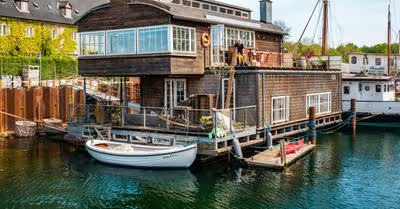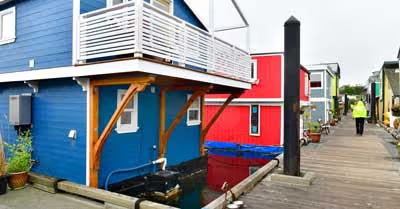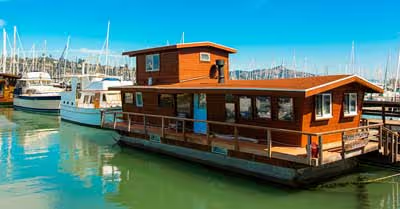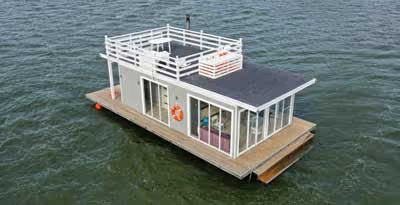
Houseboats are really big and heavy, so then how do they stay afloat while also being super comfortable to live on?
If you've ever wondered how a houseboat is able to stay afloat, then the answer is - buoyancy. Buoyancy is the density of the water pushing up the density of a boat. The lighter the materials used to build the boat, the better it'll float. This is why houseboats are made of wood or fiberglass.
This is just one of those things that people take for granted, but it's quite interesting to know how this happens. Besides, if you're buying a houseboat, the last thing you'd want is the boat to sink, even if it is that close to the water.
As experts in houseboats, we learned early on about the ancient Greek scientist Archimedes and how he was the first one to come up with what we now call the 'Archimedes' Principle, which explains to us how and why things tend to float on water.
Why Houseboats Float
Floating over a lake is a great way to spend a vacation or experience life close to the water. Whether it's on a kayak or a houseboat, spending time on the water is a real treat. But how are houseboats able to float, anyway?
Quick Example
The Pioneering Spirit is the world's heaviest marine vessel. It's a construction vessel with a total weight of 403,342 tons. This ship floats on the water despite its tremendous weight. To float, this ship displaces roughly 900,000 metric tons of water. Water has a far lower density than steel. So, how can this super-heavyweight monster ship carrying tons of construction equipment and cargo avoid sinking? While the Pioneering Spirit is a massive vessel, it is still simply a boat increased by a factor of ten. Boats float due to the fact that their density is lower than that of water.
The Archimedes Principle
As mentioned above, the science behind floating was first introduced by the Greek scientist Archimedes who was the first to figure out that whenever an object was placed into water, it pushed just enough of the water to make room. This is what we now call displacement. As in, the water is displaced to make place for the object. Whenever an object is put in the water, two forces come into play; one is gravity or the downward force, which is also determined by the object's weight. Then, there is buoyancy or the upward force, determined by the weight of water displaced due to the object.
Buoyancy
In short, objects tend to float on water if their gravitational force or downward force is less than the upward force - also known as buoyancy. So, now you know why rocks tend to sink while large barges float. While the rock displaces a little water, that's not enough to keep it afloat, and it ends up sinking, while a large barge is able to float mainly because even though the barge weighs far more than a rock, it also displaces lots of water that weighs more than the barge itself. This is the main reason why boats are specifically designed to displace as much water as possible to improve their ability to remain afloat.
Buoyancy is the fundamental concept that keeps boats afloat. For instance, a houseboat would sink a little if you pressed down on it when it was in the water. When you stopped pushing, the boat would bounce back up a little, almost as if it had been lifted, before settling back into the water. What's really happening is that the water is pushing up on the boat while the boat is pushing down.
The object will remain buoyant and float on the surface of the water if the weight of the object is equal to the pressure of the body of water. On the other hand, the object will drop below the waterline if it is excessively dense or heavy. This is the reason why houseboats have traditionally been made with wood, while modern houseboats are now made of fiberglass since both of these materials are lightweight and float well on the water. So, that's how a boat remains afloat, but it's a different story when it comes to staying upright. Of course, unlike on land, you must account for waves in the ocean, which will dramatically shift a boat.
A boat has two centers: a gravity center and a buoyancy center. The force that pulls the boat down into the water is the center of gravity, while the force that pushes the boat back is the center of buoyancy. The center of gravity of a conventional sailboat is lower than the center of buoyancy, which helps maintain the boat upright. That may not be the case in a houseboat, which may be moored to a raft and so has a greater center of gravity than the center of buoyancy.
When a boat tips to the right, its center of buoyancy changes to the right as well, since the water pushes up on the right side of the boat rather than the center. It's almost as if the water is attempting to raise the boat out of the sea, and the further out the water pushes the boat, the more likely it is to tip. The metacenter is where the center of gravity and the center of buoyancy cross. The boat is closer to flipping over the lower the junction is. The boat will flip over once the metacenter is below its center of gravity. Fortunately, this only occurs in extreme weather, where big waves may be formed by high winds, easily tipping over a houseboat; marinas are not placed in places where such weather occurs.
The righting moment is another force that maintains a houseboat upright by driving its weight down. The righting moment may even be expressed mathematically: it's just the weight of the center of gravity multiplied by the distance between the two centers. The force exerted by the righting moment on a boat weighing 15,000 pounds shifting its center of buoyancy out three feet would be 45,000 pounds per foot, an incredible amount of power. The righting moment works stronger the further the center of buoyancy swings from the center of gravity.
Wooden houseboats have an advantage over fiberglass boats in that they are significantly less expensive. Wood is also the oldest material used for houseboat construction, and many people choose a wooden boat because of its rustic appearance. However, because of the wear and tear that comes with wood, financial institutions and insurance companies are less inclined to work with you, and the boats are considerably more difficult to repair.
Wood submerged in water rots considerably faster than wood on land because fungal spores flourish in water and reproduce and kill the wood. As a result, wooden vessels must be inspected for rot on a regular basis. Boaters might use marine spar varnish, a waterproof layer, or epoxy to strengthen the structure.
Any houseboat, regardless of the material, requires some level of upkeep. Through-hulls, or openings in the hull, are found on all houseboats and allow outside water to enter interior systems such as toilets, showers, and sinks. It's critical to inspect these openings for leaks since any additional water allowed into these systems can flood the inside and cause a variety of problems.
Marinas also require measurements of the houseboat before they allow the vessel to dock at the harbor. The hull length of the boat is the amount of room you can physically walk around in. This statistic informs houseboat owners about the amount of living space available onboard. The length overall (LOA) is the whole length of the boat, measured from the very back of the stern to the very tip of the bow. This is useful information for a marina owner since it tells him how much room the yacht will take up at the dock. It's crucial to know the boat's draught or how deep it goes so the bottom doesn't scrape against rocks and cause damage to the house.
Salt Water Vs. Fresh Water
Whether the boat is sitting in fresh or saline water makes a difference. Because of the dissolved salt, which increases the bulk of saltwater, it is generally denser than freshwater. It should also be noted that seawater is heavier than fresh water because of this. The actual weight of the saltwater is determined by the quantity of dissolved salts. As a result, a vessel in saltwater will sit higher than one in freshwater.










